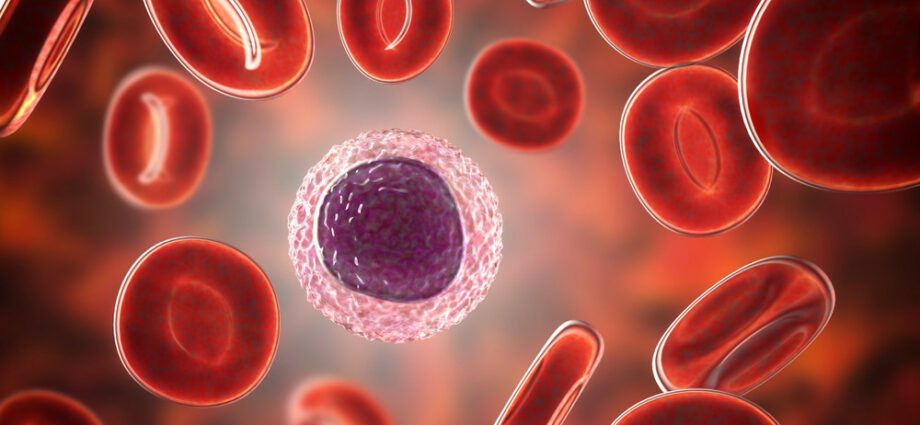Contents
Hyperlymphocytose
Hyperlymphocytosis is an abnormal increase in the number of lymphocytes in the blood. It can be acute when it is encountered during viral infections or chronic, especially when it is associated with a malignant hemopathy. Hyperlymphocytosis is diagnosed during various blood tests. And the treatment depends on the cause.
Hyperlymphocytosis, what is it?
Definition
Hyperlymphocytosis is an abnormal increase in the number of lymphocytes in the blood normally less than 4000 lymphocytes per cubic millimeter in adults.
Lymphocytes are leukocytes (in other words white blood cells) that play a vital role in the immune system. There are three types of lymphocytes:
- B lymphocytes: in contact with an antigen, they produce specific antibodies to this substance foreign to the body
- T lymphocytes: Some destroy antigens and infected cells by attaching to their cell membranes to inject them with toxic enzymes, others help B lymphocytes make antibodies, and others produce substances to stop an immune response.
- Natural Killer lymphocytes: they have a natural cytotoxic activity which allows them to spontaneously destroy cells infected with viruses or cancer cells.
Types
Hyperlymphocytosis can be:
- Acute when encountered during viral infections;
- Chronic (lasting more than 2 months) especially when it is associated with a malignant hemopathy;
Causes
Acute (or reactive) hyperlymphocytosis can be caused by:
- A viral infection (mumps, chickenpox or mononucleosis, hepatitis, rubella, HIV infection, Carl Smith disease);
- Some bacterial infections, such as tuberculosis or whooping cough, can have the same effect;
- Taking certain medications;
- The vaccination ;
- Endocrine disorders;
- Autoimmune diseases;
- Smoking;
- Stress: hyperlymphocytosis is observed in patients exposed to various acute traumatic, surgical or cardiac events, or during significant physical exertion (childbirth);
- Surgical removal of the spleen.
Chronic hyperlymphocytosis can be caused by:
- Leukemias, especially lymphoid leukemia;
- Lymphomas;
- Chronic inflammation, especially of the digestive system (Crohn’s disease).
Diagnostic
Hyperlymphocytosis is diagnosed during various blood tests:
- The complete blood count: biological test which makes it possible to quantify the cellular elements which circulate in the blood (white blood cells, red blood cells and platelets) and to determine the proportion of the different white blood cells (in particular lymphocytes);
- When the blood count shows an increase in the number of lymphocytes, the doctor examines a sample of blood under a microscope to determine the morphology of the lymphocytes. A great heterogeneity in the morphology of the lymphocytes often characterizes a mononucleosis syndrome, and the presence of immature cells is characteristic of certain leukemias or lymphomas;
- Finally, additional blood tests can also identify the specific type of lymphocyte (T, B, NK) that is increased to help determine the cause.
The people concerned
Hyperlymphocytosis affects both children in whom it is always reactive and transient, as well as adults in whom it can be transient or chronic (they are then of malignant origin in 50% of cases).
Symptoms of hyperlymphocytosis
By itself, the increase in the number of lymphocytes does not usually cause symptoms. However, in people with lymphoma and certain leukemias, hyperlymphocytosis can cause:
- Fever ;
- Night sweats ;
- Weightloss.
Treatments for hyperlymphocytosis
Treatment for hyperlymphocytosis depends on its cause, including:
- Symptomatic treatment in most viral infections causing acute hyperlymphocytosis;
- Antibiotic treatment for bacterial infections;
- Chemotherapy, or sometimes stem cell transplantation, to treat leukemia;
- Removal of the cause (stress, smoking)
Prevent hyperlymphocytosis
Prevention of acute hyperlymphocytosis involves preventing viral and bacterial infections that can cause the disorder:
- Vaccination, especially against mumps, rubella, tuberculosis or whooping cough;
- Routine use of condoms during sex to protect against HIV.
On the other hand, there is no preventive measure for chronic hyperlymphocytosis.










